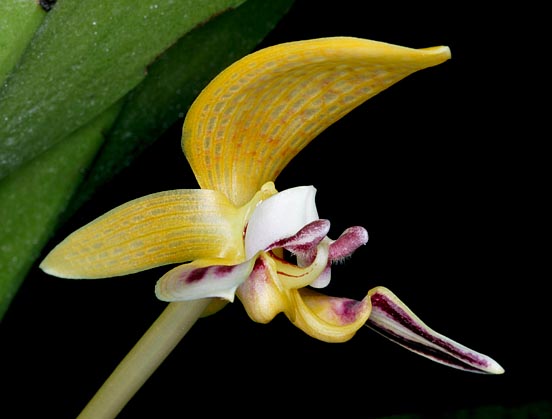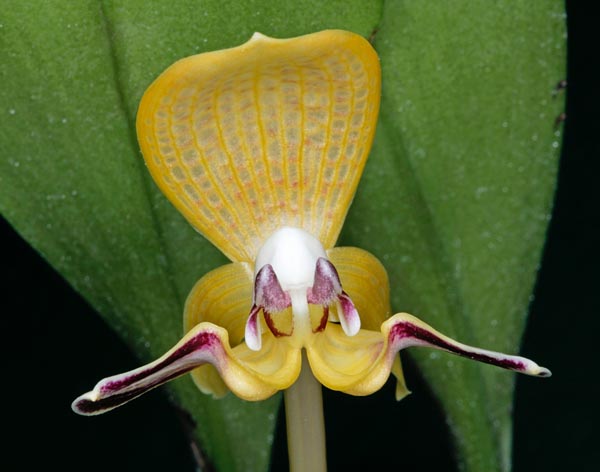Family : Orchidaceae

Text © Pietro Puccio

English translation by Mario Beltramini

A giggling pirate? No, it’s a Bulbophyllum dearei flower profile © Giuseppe Mazza
The species is native to Borneo, peninsular Malaysia and Philippines, where it grows, epiphytic, in the humid forests, between the 700 and the 1200 m of altitude.
The name of the genus is the combination of the Greek terms “bulbos” = bulb, and “phyllon” = leaf, with reference to the leaves growing at the apex of the pseudobulbs; the species is honoured to an English collector, whose name was Deare, who had carried from Borneo, in whose greenhouse it has bloomed for the first time in England.
Common names: Deare’s bulbophyllum (English).
The Bulbophyllum dearei (Rchb.f.) Rchb.f. (1888) is an epiphytic orchid, rarely lithophytic, with oblong, tight, pseudobulbs, of about 3 cm of length and 1 cm of diameter, equipped of only one leaf at the apex, on a 3 cm long petiole, leathery, elliptic-oblong, of 10-16 cm of length and 4-5 cm broad.
It has a solitary flower from the base of the pseudobulb, on an erect, up to about 16 cm long, peduncle, with an ovate-lanceolate dorsal sepal, pointed, leaning forward, about 4 cm long and 1,5 cm broad, of ochre yellow colour spotted of red, and lateral, lanceolate-falcate, sepals, about 2,8 cm long and 0,8 cm broad, with purple spots.
The petals are linear lanceolate, retroflexed, about 3 cm long and 1 cm broad, of ochre yellow colour with darker venations and some purple red spot, the labellum is mobile, a characteristic of the genus for favouring the pollination, triangular shaped with bent apex, about 1,2 cm long and 0,6 cm broad, yellowish white spotted of purple, the column is short, of ochre yellow colour with red margins.
The flower is slightly perfumed and lasts 1-2 weeks. It usually reproduces by division with each section provided at least of 4-5 pseudobulbs.

Epiphyte with one-leaved pseudobulbs. The scented and solitary flower lasts even 2 weeks © Mazza
It’s a species standing among the most ornamental of the genus; it requires medium-high temperatures in summer, 26-32 °C, with high humidity, about the 60% and frequent waterings, little lower temperatures in winter, 16-20 °C, and less frequent waterings, but never letting dry completely, and a much luminous position, but not in direct sun; a good ventilation is fundamental.
For the waterings and nebulisations, is to be used the rainwater, or water obtained by reverse osmosys or demineralized; the fertilizations, appropriately distributed in way to avoid accumulations of salts, are to be done preferably with balanced water soluble products, with microelements, at half dosage, or less, of what advised in the packaging.
It can be placed on a cork raft, pieces of bark, with, if necessary, some sphagnum at the base, in a low pot or a basket, with medium-sized bark or coir. It is rather sensitive to the damaging to the roots, a special attention is to be done when changing pots and moving, things which are better to be reduced at the minimum.
The species is inscribed into the appendix II of the CITES (species whose trade is ruled internationally).
Synonyms: Bulbophyllum dearei A.H.Kent (1888); Sanopodium dearei (Rchb. f.) hort. ex Rchb. f. (1888); Sarcopodium dearei Rchb.f. (1888); Bulbophyllum godseffianum Weathers (1890); Phyllorchis dearei (Rchb. f.) Kuntze (1891); Phyllorkis dearei (Rchb.f.) Kuntze (1891); Bulbophyllum reticosum Ridl. (1896); Bulbophyllum punctatum Ridl. (1908).
